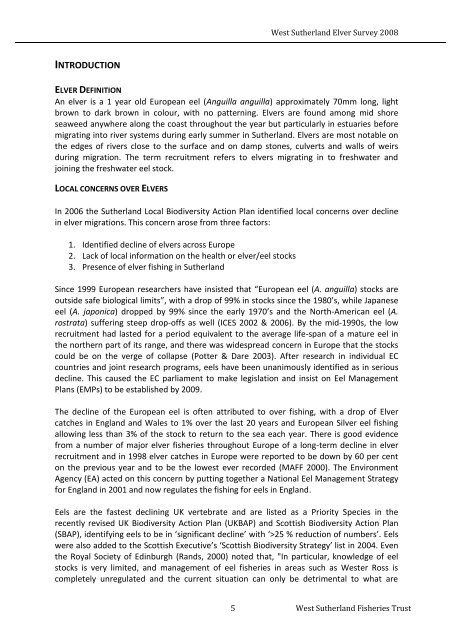West Sutherland Elver Survey
West Sutherland Elver Survey
West Sutherland Elver Survey
You also want an ePaper? Increase the reach of your titles
YUMPU automatically turns print PDFs into web optimized ePapers that Google loves.
INTRODUCTION<br />
<strong>West</strong> <strong>Sutherland</strong> <strong>Elver</strong> <strong>Survey</strong> 2008<br />
ELVER DEFINITION<br />
An elver is a 1 year old European eel (Anguilla anguilla) approximately 70mm long, light<br />
brown to dark brown in colour, with no patterning. <strong>Elver</strong>s are found among mid shore<br />
seaweed anywhere along the coast throughout the year but particularly in estuaries before<br />
migrating into river systems during early summer in <strong>Sutherland</strong>. <strong>Elver</strong>s are most notable on<br />
the edges of rivers close to the surface and on damp stones, culverts and walls of weirs<br />
during migration. The term recruitment refers to elvers migrating in to freshwater and<br />
joining the freshwater eel stock.<br />
LOCAL CONCERNS OVER ELVERS<br />
In 2006 the <strong>Sutherland</strong> Local Biodiversity Action Plan identified local concerns over decline<br />
in elver migrations. This concern arose from three factors:<br />
1. Identified decline of elvers across Europe<br />
2. Lack of local information on the health or elver/eel stocks<br />
3. Presence of elver fishing in <strong>Sutherland</strong><br />
Since 1999 European researchers have insisted that “European eel (A. anguilla) stocks are<br />
outside safe biological limits”, with a drop of 99% in stocks since the 1980’s, while Japanese<br />
eel (A. japonica) dropped by 99% since the early 1970’s and the North-American eel (A.<br />
rostrata) suffering steep drop-offs as well (ICES 2002 & 2006). By the mid-1990s, the low<br />
recruitment had lasted for a period equivalent to the average life-span of a mature eel in<br />
the northern part of its range, and there was widespread concern in Europe that the stocks<br />
could be on the verge of collapse (Potter & Dare 2003). After research in individual EC<br />
countries and joint research programs, eels have been unanimously identified as in serious<br />
decline. This caused the EC parliament to make legislation and insist on Eel Management<br />
Plans (EMPs) to be established by 2009.<br />
The decline of the European eel is often attributed to over fishing, with a drop of <strong>Elver</strong><br />
catches in England and Wales to 1% over the last 20 years and European Silver eel fishing<br />
allowing less than 3% of the stock to return to the sea each year. There is good evidence<br />
from a number of major elver fisheries throughout Europe of a long-term decline in elver<br />
recruitment and in 1998 elver catches in Europe were reported to be down by 60 per cent<br />
on the previous year and to be the lowest ever recorded (MAFF 2000). The Environment<br />
Agency (EA) acted on this concern by putting together a National Eel Management Strategy<br />
for England in 2001 and now regulates the fishing for eels in England.<br />
Eels are the fastest declining UK vertebrate and are listed as a Priority Species in the<br />
recently revised UK Biodiversity Action Plan (UKBAP) and Scottish Biodiversity Action Plan<br />
(SBAP), identifying eels to be in ‘significant decline’ with ‘>25 % reduction of numbers’. Eels<br />
were also added to the Scottish Executive’s ‘Scottish Biodiversity Strategy’ list in 2004. Even<br />
the Royal Society of Edinburgh (Rands, 2000) noted that, "In particular, knowledge of eel<br />
stocks is very limited, and management of eel fisheries in areas such as <strong>West</strong>er Ross is<br />
completely unregulated and the current situation can only be detrimental to what are<br />
5 <strong>West</strong> <strong>Sutherland</strong> Fisheries Trust











